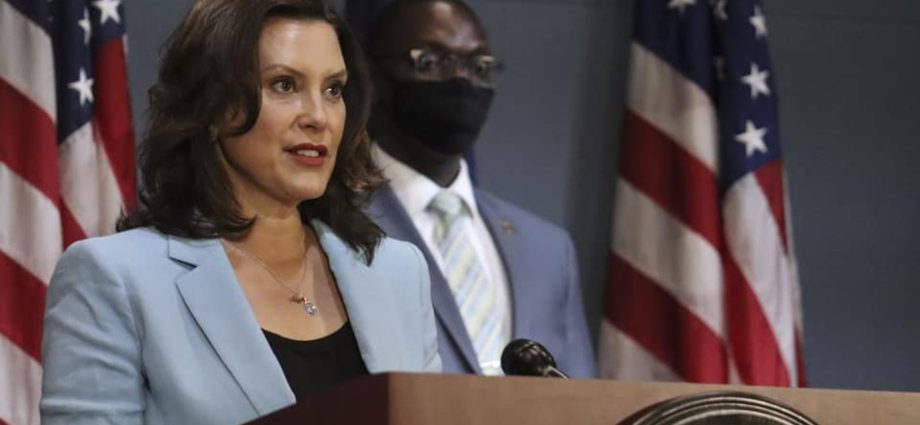What you need to know about Line 5, the latest pipeline fight
Michigan Gov. Gretchen Whitmer in July 2020. Line 5’s future is now in jeopardy after Whitmer yanked its decades-old authorization last November, giving Enbridge until May to cease operations. Photo from Gretchen Whitmer / Facebook. Carl Meyer, Local Journalism Initiative Reporter
By Carl Meyer, Local Journalism Initiative Reporter, Canada’s National Observer
Jan 29, 2021
A legal battle has erupted over the Enbridge Line 5 pipeline and it has spilled into the halls of Canada’s Parliament.
Line 5, built in 1953, is part of Alberta-based Enbridge’s “Lakehead” network of pipelines around the Great Lakes. The pipeline carries up to 540,000 barrels per day of fossil fuel products across Wisconsin and Michigan to refineries in the Upper Midwest and Eastern Canada, ending at Sarnia in southern Ontario.
Its future is now in jeopardy after Michigan Gov. Gretchen Whitmer yanked its decades-old authorization last November, giving Enbridge until May to cease operations.
The energy company has been defiant, declaring the move “unlawful” and vowing to continue to push product through the pipeline anyway. And Canada’s official Opposition Conservatives are arguing the federal government isn’t paying close enough attention.
At issue is the route of Line 5, which passes through the narrows that connect Lake Michigan with Lake Huron, called the Straits of Mackinac, an environmentally sensitive area where currents can often change direction, leading to choppy waters and the erosion of the lakebed.

Engineers originally constructed the pipeline using a novel method, thickening the pipe walls, coating it in enamel and splitting it into two parallel pipes before it made the 7.2-kilometre crossing along the bottom of the waterway.
Enbridge says Line 5 has served the region “safely and reliably for more than six decades” and says it inspects the dual pipes regularly, monitors the straits crossing around the clock and takes other safety measures.
But the pipeline has also seen work. A 2017 report from the Milwaukee Journal Sentinel detailed a decades-long effort to fortify the pipes. The company has used grout-filled sacks and anchor supports to hold the pipes in place.
In 2018, the dual pipes were struck by an anchor that had been unknowingly released from a barge and was dragging along the bottom of the lake. The pipes weren’t ruptured, but they were dented. Last summer, one of the supports shifted, briefly causing one of the pipes to be shut down.
Enbridge said an inspection showed no damage. But the 2018 incident was cited by Whitmer in her conclusion that continued operation of the pipeline violates the public trust doctrine, which holds that the state of Michigan must protect the “public’s rights in the Great Lakes.”
“Enbridge has imposed on the people of Michigan an unacceptable risk of a catastrophic oil spill in the Great Lakes that could devastate our economy and way of life,” Whitmer said in a statement.
Enbridge is asking the United States District Court to reverse Michigan’s decision, suggesting it was already cleared by the U.S. Pipeline and Hazardous Materials Safety Administration in June and September 2020. It said the administration said Sept. 4, 2020 that no “integrity issues” were identified.
The company said it intends to continue to operate the dual pipes until it can reroute the pipeline through a new tunnel that it plans to dig under the bedrock of the waterway. Initial design work on this Great Lakes Tunnel, as the company is calling it, was “nearly complete.”
“Our review shows that the state lacks the authority to terminate,” Enbridge said Jan. 12. “Our dual lines in the straits are safe and in full compliance with the federal pipeline safety standards that govern them.”
The company says it has opened the Enbridge Straits Maritime Operations Center, meant to monitor vessel traffic in the straits and warn approaching vessels.
Trudeau: ‘Continue to work to ensure energy security’
This week, federal Conservative Leader Erin O’Toole demanded in the House of Commons that Prime Minister Justin Trudeau raise the issue with U.S. President Joe Biden.
“Specifically, why has Line 5, the thousands of jobs, the decades of a safe record, not been a priority for the prime minister?” he asked during Jan. 27 question period.
Trudeau replied that he felt all Canadians knew “that this government has consistently stood up for Canadian interests with a challenging situation south of the border over the past four years.”
“We are going to continue to work to ensure energy security and jobs for Canadians, and continue the fight against climate change hand in hand with the American government,” said the prime minister.
Natural Resources Minister Seamus O’Regan has also called Line 5 “essential” and said the federal government supports the project.
The issue of jobs has been top of mind for Sarnia Mayor Mike Bradley, who wrote a letter to Trudeau on Jan. 4 expressing “deep concern” over the decision by Michigan to revoke the authorization.
“The Sarnia community and region of southwestern Ontario relies on Line 5 for thousands of jobs and economic output that strengthens both Ontario and Canada,” he wrote.
Critics, however, say that shutting down Line 5 won’t necessarily lead to the closure of facilities and the loss of thousands of jobs. The advocacy group For Love of Water argues that “multiple alternative pipelines, rail, and truck sources” are available to refineries in the region.
Subscribe to our newsletter.
Bradley told Canada’s National Observer that he expected 3,000 jobs in the Sarnia area to be at risk, but he said he couldn’t estimate how many jobs would actually be lost if alternative sources like rail and truck were used.

